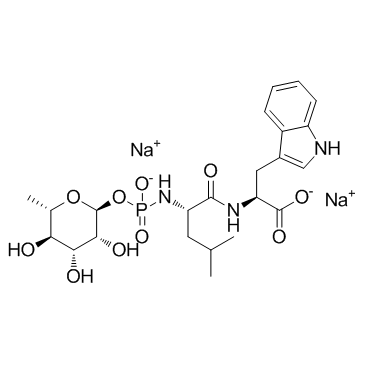Phosphoramidon disodium salt
Modify Date: 2024-01-01 21:25:37

Phosphoramidon disodium salt structure
|
Common Name | Phosphoramidon disodium salt | ||
|---|---|---|---|---|
| CAS Number | 164204-38-0 | Molecular Weight | 587.47 | |
| Density | N/A | Boiling Point | N/A | |
| Molecular Formula | C23H32N3Na2O10P | Melting Point | N/A | |
| MSDS | Chinese | Flash Point | N/A | |
Use of Phosphoramidon disodium saltPhosphoramidon disodium is a metalloprotease inhibitor. Phosphoramidon inhibits endothelin-converting enzyme (ECE), neutral endopeptidase (NEP), and angiotensin-converting enzyme (ACE) with IC50 values of 3.5, 0.034, and 78 μM, respectively. |
| Name | L-Tryptophan, N-[N-[[(6-deoxy-α-L-mannopyranosyl)oxy]hydroxyphosphinyl]-L-leucyl]-, sodium salt |
|---|---|
| Synonym | More Synonyms |
| Description | Phosphoramidon disodium is a metalloprotease inhibitor. Phosphoramidon inhibits endothelin-converting enzyme (ECE), neutral endopeptidase (NEP), and angiotensin-converting enzyme (ACE) with IC50 values of 3.5, 0.034, and 78 μM, respectively. |
|---|---|
| Related Catalog | |
| Target |
IC50: 3.5 μM (ECE), 34 nM (NEP), 78 μM (ACE)[1] |
| In Vitro | Phosphoramidon is a naturally occurring glycopeptide first isolated from a strain of Streptomyces tanashiensis. It has a unique chemical structure featuring a phosphoramidate linkage between a-L-rhamnose and L-leucineL-tryptophan. As a microbial metabolite, phosphoramidon exhibits potent inhibitory activity against thermolysin, a zinc endopeptidase isolated from Bacillus thermoproteolyticus (Ki=32 nM)[2]. |
| In Vivo | Intranasal administration of phosphoramidon produces significantly elevated cerebral Aβ levels in wild-type mice. Furthermore, intranasal phosphoramidon administration in double knockout mice lacking NEP and NEP2 also shows increased levels of Aβ40[3]. Phosphoramidon blocks the formation of endothelin-1 (ET-1), a proinflammatory mediator implicated in the pathogenesis of a variety of lung diseases. Phosphoramidon significantly reduces LPS-induced pulmonary inflammation as measured by lung histology, neutrophil content of bronchoalveolar lavage (BAL) fluid, percent tumor necrosis factor receptor 1 (TNFR1)-labeled BAL macrophages, and alveolar septal cell apoptosis[4]. Phosphoramidon significantly decreased ET-1 levels, causing a concomitant big ET-1 increase and dose-dependently attenuated indomethacin-induced gastric mucosal damage[5]. |
| Kinase Assay | The Ki values are determined in a 50 mM Tris-HCl, 10 mM CaCl2 buffer (pH 7.5) with FA-Gly-Leu-NH2 (FAGLA) as a substrate by using an Agilent 8453 UV-vis spectrophotometer in triplicate. Henderson plots are employed for the calculation of Ki values. A mixture of buffer (970 μL), phosphoramidon (0-80 nM, 20 μL), and thermolysin (40 nM, 10 μL) is incubated at 25 C for 15 min in a cuvette (2 mL). A solution of FAGLA (0.1-0.5 mM, 1.0 mL) in Tris buffer pH 7.5 is added into the cuvette. The absorbance decrease upon cleavage of FAGLA by thermolysinis recorded at 340 nm wavelength for 5 min. The concentration of thermolysinis determined from the molar extinction coefficient[2]. |
| Animal Admin | Mice[3] Phosphoramidon is dissolved in phosphate-buffered saline (PBS+1 mM ascorbic acid) at a concentration of 30 mM. Anesthetized mice are placed on their backs and eight 3-μL drops of phosphoramidon solution are administered to alternating nares every 2 min. This is done once per day for 5 days. Mice are euthanized under anesthesia for tissue collection 2 h post phosphoramidon administration on day 5. Control mice are treated with intranasal PBS vehicle solution alone. Brains are removed and dissected into the desired brain regions before being homogenized in 5 M guanidine HCl to extract total Aβ. After centrifugation (16,000×g), the supernatants are diluted tenfold and Aβ (1-42 and 1-40) is quantified by specific ELISA. Rats[4] Animals are treated with phosphoramidon either intraperitoneally or intratracheally via nebulization. To examine the effects of intraperitoneal administration, animals are injected with 0.5 mg of phosphoramidon dissolved in 0.5 mL of phosphatebuffered saline (PBS). For the nebulization studies, animals are placed in an exposure chamber and treated for 1 hour with an aerosol composed of a 0.1% solution of phosphoramidon dissolved in distilled water. The aerosolized phosphoramidonis delivered through a ceiling port via a Misty-Ox nebulizer attached to an air compressor. Negative pressure is applied by a blower attached to a secondary outflow port to insure proper circulation of the aerosol. |
| References |
| Molecular Formula | C23H32N3Na2O10P |
|---|---|
| Molecular Weight | 587.47 |
| PSA | 220.48000 |
| LogP | 1.01040 |
| Storage condition | -20℃ |
| Phosphoramidon disodium salt |
| N-(α-Rhamnopyranosyloxyhydroxyphosphinyl)-Leu-Trp disodium salt |
| Disodium (2S)-3-(1H-indol-3-yl)-2-({(2S)-4-methyl-2-[({[(2S,3R,4R,5R,6S)-3,4,5-trihydroxy-6-methyltetrahydro-2H-pyran-2-yl]oxy}phosphinato)amino]pentanoyl}amino)propanoate |
| N-(α-Rhamno- pyranosyl- phos- phono)-L-leucyl-L-tryptophan disodium salt |
| N-(α-Rhamno- pyranosyl- oxy- hydroxy- phosphinyl)-Leu-Trp disodium salt |
| Phosphoramidon (Disodium) |